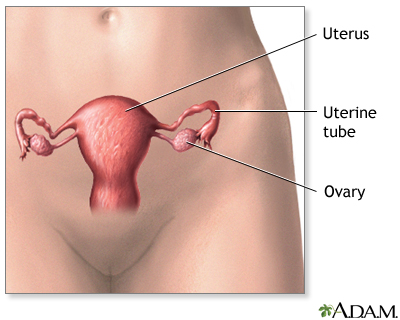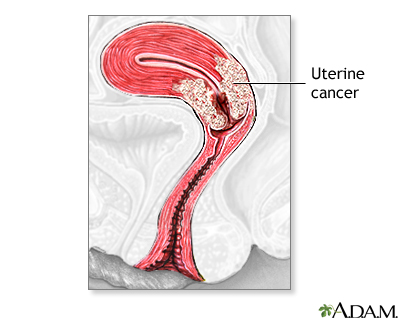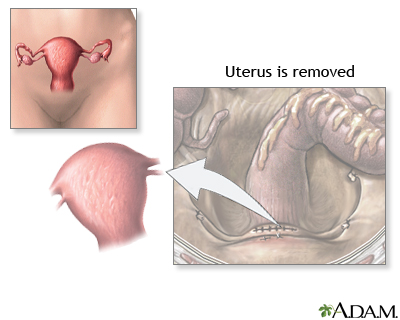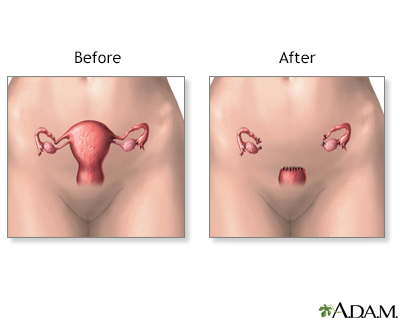Hysterectomy
Normal anatomy
|
|
The uterus is joined at the cervix to the vagina and by the fallopian or uterine tubes to the ovaries.
|
Indications
|
|
A hysterectomy is the removal of the uterus, resulting in the inability to become pregnant (sterility). May be done through the abdomen or the vagina.
Hysterectomy may be recommended for:
- Severe, long-term (chronic) infections (pelvic inflammatory disease)
- Severe inflammation of the lining of the uterus (endometriosis)
- Tumors in the uterus
- Uterine fibroids, cancer of the endometrium
- Cancer of the cervix, cancer of the ovary
- Severe, long-term (chronic) vaginal bleeding
|
Procedure
|
|
Hysterectomy is a very common operation. The uterus may be completely removed, partially removed, or may be removed with the tubes and ovaries. A partial hysterectomy is removal of just the upper portion of the uterus, leaving the cervix and the base of the uterus are left intact. A total hysterectomy is removal of the entire uterus and the cervix. A radical hysterectomy is the removal of the uterus, both fallopian tubes, both ovaries, and the upper part of the vagina.
A hysterectomy may be done through an abdominal incision (abdominal hysterectomy) or through a vaginal incision (vaginal hysterectomy).
|
Aftercare
|
|
Most patients recover completely from hysterectomy. Removal of the ovaries causes immediate menopause and hormone replacement therapy (estrogen) may be recommended.
The average hospital stay is from 5 to 7 days. Complete recovery may require 2 weeks to 2 months. Recovery from a vaginal hysterectomy is faster than from a abdominal hysterectomy. If the bladder was involved, then a catheter may remain in place for 3 to 4 days to help the bladder pass urine. Moving about as soon as possible helps to avoid blood clots in the legs and other problems. Walking to the bathroom as soon as possible is recommended. Normal diet is encouraged as soon as possible after bowel function returns. Avoid lifting heavy objects for a few weeks following surgery. Sexual activities should be avoided for 6 to 8 weeks after a hysterectomy.
|

Review Date:1/10/2022
Reviewed By:John D. Jacobson, MD, Department of Obstetrics and Gynecology, Loma Linda University School of Medicine, Loma Linda, CA. Also reviewed by David Zieve, MD, MHA, Medical Director, Brenda Conaway, Editorial Director, and the A.D.A.M. Editorial team.
The information provided herein should not be used during any medical emergency
or for the diagnosis or treatment of any medical condition. A licensed medical professional
should be consulted for diagnosis and treatment of any and all medical conditions. Call 911
for all medical emergencies. Links to other sites are provided for information only -- they
do not constitute endorsements of those other sites. © 1997-A.D.A.M., Inc. Any duplication or distribution of the information contained herein is strictly prohibited.
The Agency for Health Care Administration (Agency) and this website do not claim the information on, or referred to by, this site is error free. This site may include links to websites of other government agencies or private groups. Our Agency and this website do not control such sites and are not responsible for their content. Reference to or links to any other group, product, service, or information does not mean our Agency or this website approves of that group, product, service, or information.
Additionally, while health information provided through this website may be a valuable resource for the public, it is not designed to offer medical advice. Talk with your doctor about medical care questions you may have.




